The Guava tree is beautiful. Both the leaves and the flowers are slightly fragrant and attractive. The Guava tree, if grown in the ground, can grow up to 12 feet in height in the tropics. Fertilizing the Guava tree at the right time will ensure it gets the nutrients it needs to grow healthy. Let’s check out more information about fertilizer management in Guava trees.
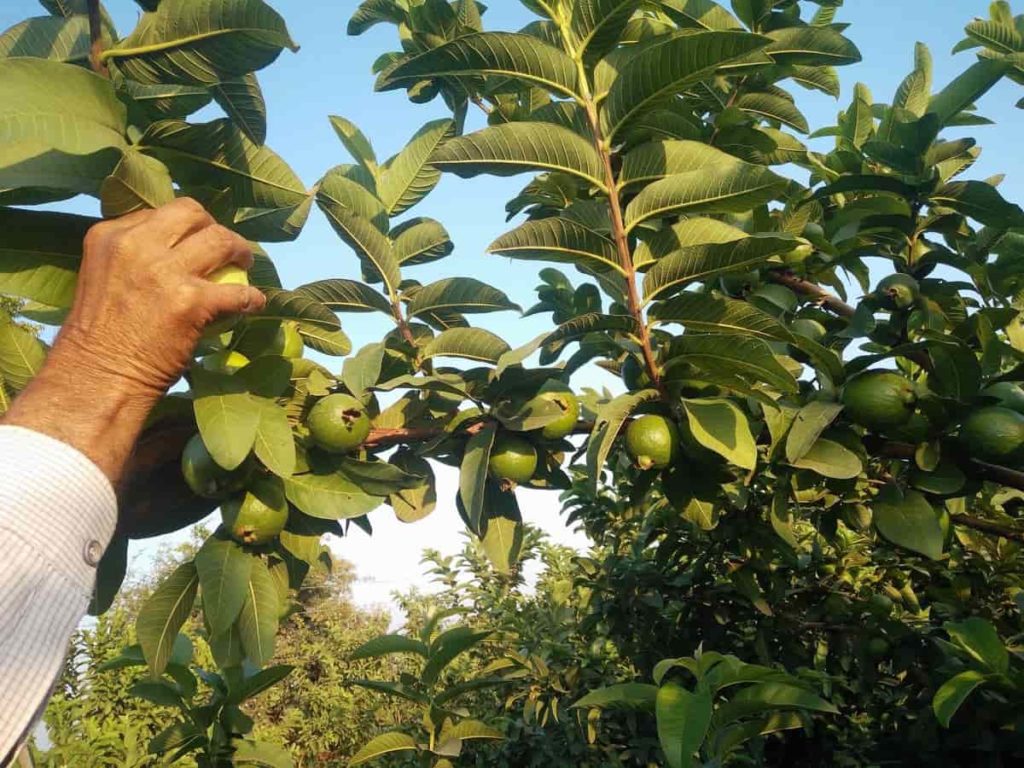
Making compost and supplementing the soil with nutrients are different ways to make a common land more agriculturally valuable. Adding fertilizer to the soil helps increase the amount of nitrogen, phosphorus, potassium, manganese, iron, and copper in the soil. You can increase potassium levels a bit if you want to promote good fruit growth once polished, but not necessarily if you adapt. Once your Guava tree is established and its first year has passed, apply more fertilizer per dose but cut it every other month.
A slow-release compound is still preferred, and granular varieties are ideal. Sprinkle it evenly over the root zone. You can work it on the surface of the soil if you wish. Even so, fertilizing your plants may not be an interesting part of your gardening. Still, it is important to know that a simple understanding of fertilizer management is essential for growing a healthy plant. Below information is about the fertilizer schedule for the Guava tree;
Fertilizer management in Guava trees
Tips for fertilizer application in Guava trees
- Green manure applies during the rainy season.
- During the first three years of planting, grow legumes or intercropped vegetables, provided irrigation is available.
- Fertilizers should be used based on soil testing values and recommendations for agro-ecological zones.
- Increase 100 grams nitrogen, 100 grams potash, and 40 grams phosphorus every year till the plants are five years old, and then apply 500 grams nitrogen, 200 grams phosphorus, and 500 grams potash per year. Half of the nitrogen should be given in the form of organic fertilizer.
Fertilizer application time in Guava trees
The timing of fertilizer application depends on the area and the crop type.
- Fertilize after the first pre-monsoon shower (June) for the rainy season crop and in the first week of September for the winter crop. For one-year-old plants, apply 100 grams nitrogen, 40 grams phosphorus, and 100 grams potash in two parts (June and September) except phosphorus.
- During continuous growth, you will increase the frequency of fertilization three to four times a year, but you will be increasing the fertilizer dose to two pounds (907 grams) per plant. Using nutritional sprays of copper and zinc to fertilize the Guava tree is also recommended. Spray these plants three times a year, from spring to summer, for the first two years of growth and then once a year.
In case you missed it: Organic Guava Cultivation, Farming Practices
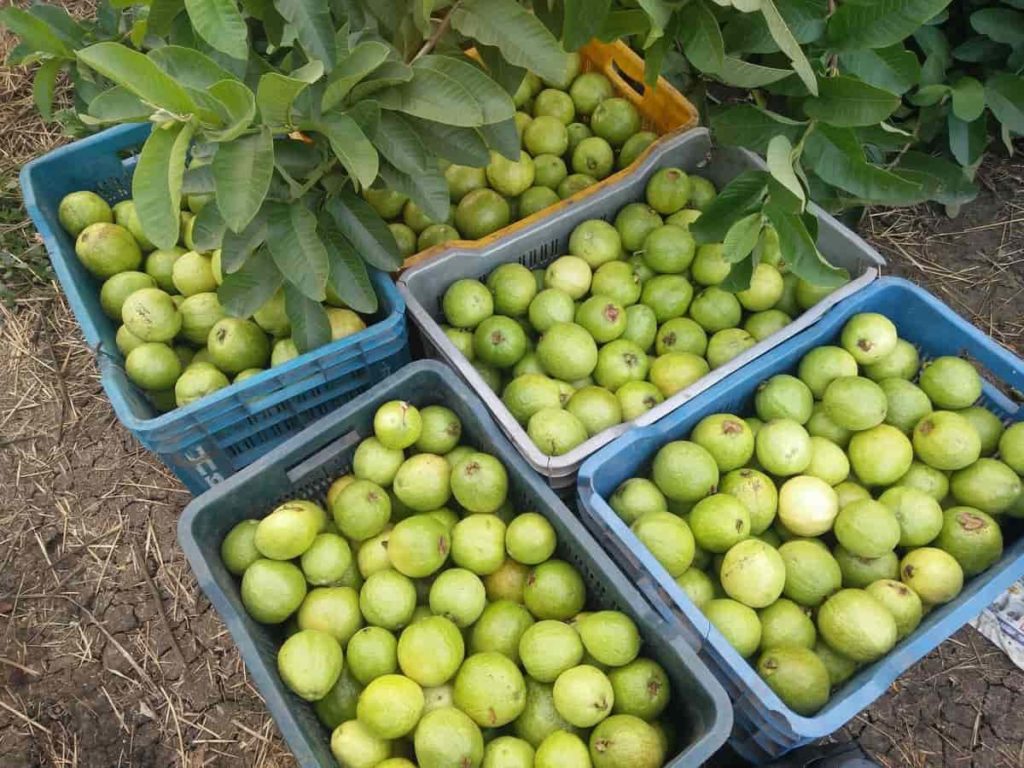
How to fertilize a Guava tree
The best-known fertilizer for Guava – Guava is classified as a heavy feeder, meaning they need more nutrients than the average plant. Regular Guava tree fertilizer is required to ensure high-quality flower and fruit production. It is recommended to use Guava tree fertilizer in the ratio of 6-6-6-2 (Nitrogen-Phosphorus-Potassium-Magnesium).
For each feed, spread the fertilizer evenly on the ground, starting one foot (30 cm) from the trunk, then spreading to the tree’s drip line—rack in it, then water. The most popular fertilizers for Guava are 6-6-6-4, 8-8-8-2, and 8-8-8 fertilizers. Young Guavas can be fed every two months, whereas well-grown Guavas are fed yearly.
Different forms of fertilizers in Guava trees
Organic fertilizers
It is a form of fertilizer made from organic matter. Fertilizing your Guava orchard with compost is an inexpensive and efficient farming method that can help increase the activity of soil microorganisms, such as earthworms, which can improve soil fertility and help speed up the process of growing your Guava plant.
Organic fertilizer can be made from leftover fertilizers and clippings, making it cost-effective. The most common ingredients in home cooking are cotton seed meal, alfalfa meal, or fish emulsion for nitrogen. Bone meal or rock phosphate is used to provide phosphorus. Granite meal or Kelp meal is used to providing potassium.
You can use animal waste products such as cow dunks, egg shells, and burnt ashes. The problem with organic fertilizer is that it is formed slowly. The manure must be digested in the soil before the Guava plant can get the nutrients. Still, once the fertilizer is digested, the Guava plant or any plant fed with this type of fertilizer can access large amounts of nutrients for a very long time. In addition, organic fertilizers increase the agricultural value of the soil by increasing the biological activity of soil organisms.
In case you missed it: Guava Pests, Diseases, and Control, Guava Plant Care
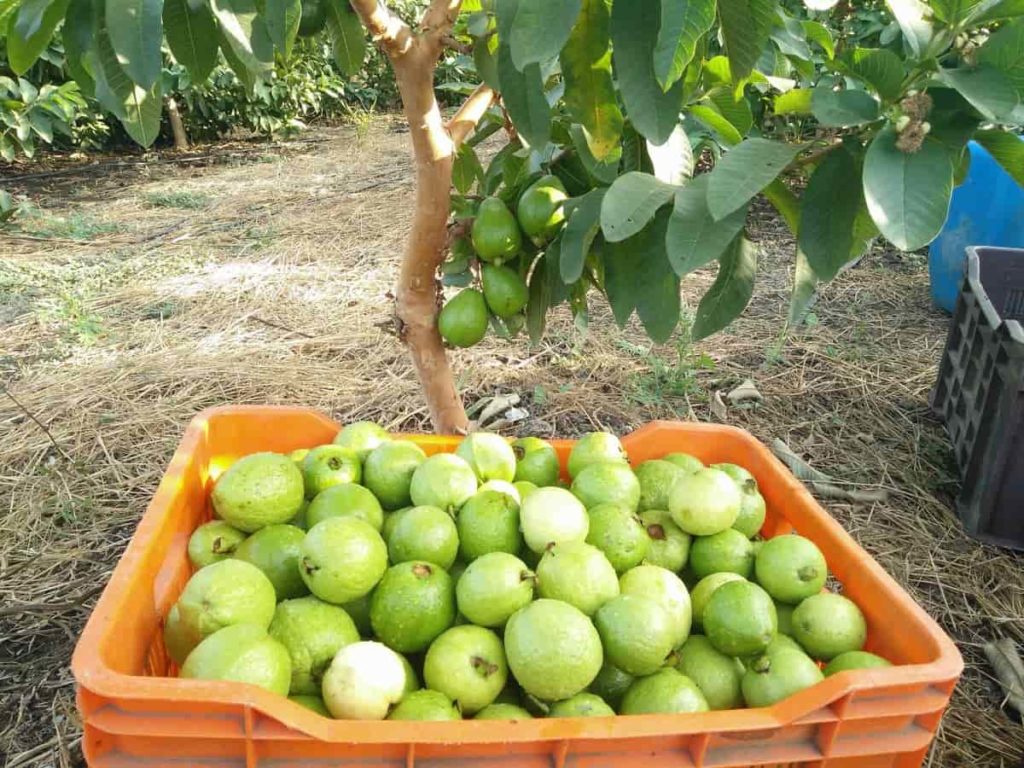
Inorganic Fertilizers
Inorganic fertilizer is also called chemical or synthetic fertilizer. This fertilizer is made from synthetic chemicals containing concentrated amounts of concentrated nitrogen N, potassium K, and phosphorus P. This fertilizer quickly replenishes the Guava plant with essential nutrients after feeding. However, inorganic fertilizers have many advantages and disadvantages.
They do not improve soil quality and the biological activity of soil organisms. Furthermore, when Guava trees are used for too long with too much inorganic fertilizer, this fertilizer can lead to poor growth of Guava. Popular inorganic fertilizers for Guava trees include;
- 6-6-6-2 (Nitrogen-Phosphorus-Potassium-Magnesium)
- 6-6-6-4 (Nitrogen-Phosphorus-Potassium-Magnesium)
- 8-8-8 -2 (Nitrogen-Phosphorus-Potassium-Magnesium)
- 8-8-8 (Nitrogen-Phosphorus-Potassium)
Liquid fertilizers
- Seaweed Extract
- Epsom Salt
NPK fertilizers
Guava trees should be fertilized with about 300-400 grams of nitrogen, 250 grams to 350 grams of P2O5 and K2O, and 30-40 kg FYM yearly. In the case of young plants, the fertilizer can be applied in a round trench around the root zone. In the case of older plants, the fertilizer can be transmitted at a radius of 120 cm from the base and can be lightly pruned without damaging the roots. Organic fertilizers can be applied to the surface as mulch.
Foliar spraying of potassium (as potassium sulfate 1.0 to 2.0%) and calcium (as calcium nitrate, 1.0 to 2.0%) on plants has increased yields and improved fruit quality. For the first four years of planting, FYM is applied in June. For Guava tree growth, inorganic fertilizers are given in three doses distributed evenly in July, September, and February. During treatment, i.e., when irrigation is cut off, a half dose of nitrogen and a full dose of phosphorus and potassium should be given along with FYM. The remaining half of N is given 1 to 1.5 months after fruiting.
Guava fertilizer for growing your tree fast
- Farming is essential if you want to grow your Guava tree fast.
- The Guava tree is heavy food, so it should be fertilized every 1-2 months when it is young. Then apply 3-4 times a year.
- Guava trees require nutrients like nitrogen, phosphorus, potash, and some magnesium to produce maximum fruit. 6-6-6-2 Apply fertilizer 3-4 times at the beginning of the growing season.
- Potassium-rich fertilizer is the best for Guava trees to increase fruit production. Feed Guava plants with liquid fertilizer during the growing season.
- Guava trees become iron deficient in alkaline and high pH soils. Fertilize 1-2 times per year with iron sulfate.
- Always water the Guava tree after fertilizing to minimize the risk of burns.
Homemade Fertilizer for Guava Tree
Organic fertilizer can be made from simple waste ingredients at home.
What do you need?
5-gallon bucket, cup, Epsom salt, cow urine, wood ash, grass clippings, and green weed.
Measure 2 cups of Epsom salt, 2 cups of urine, and 2 cups of wood ash. Place these all ingredients in a 5-gallon bucket and then mix well. Then, add grass clippings and green weeds to make half the bucket. After that, fill the rest of the bucket with water. Keep this bucket separate and let it stand for three days.
After three days, remove the bucket and transfer the tea to another container using a strainer. To feed Guava trees, you need to dilute the tea with 50% water to reduce the concentration. Next, apply this homemade fertilizer to the soil around your Guava trees.
In case you missed it: Taiwan Guava Farming, Planting, Harvesting, Yield, Profit
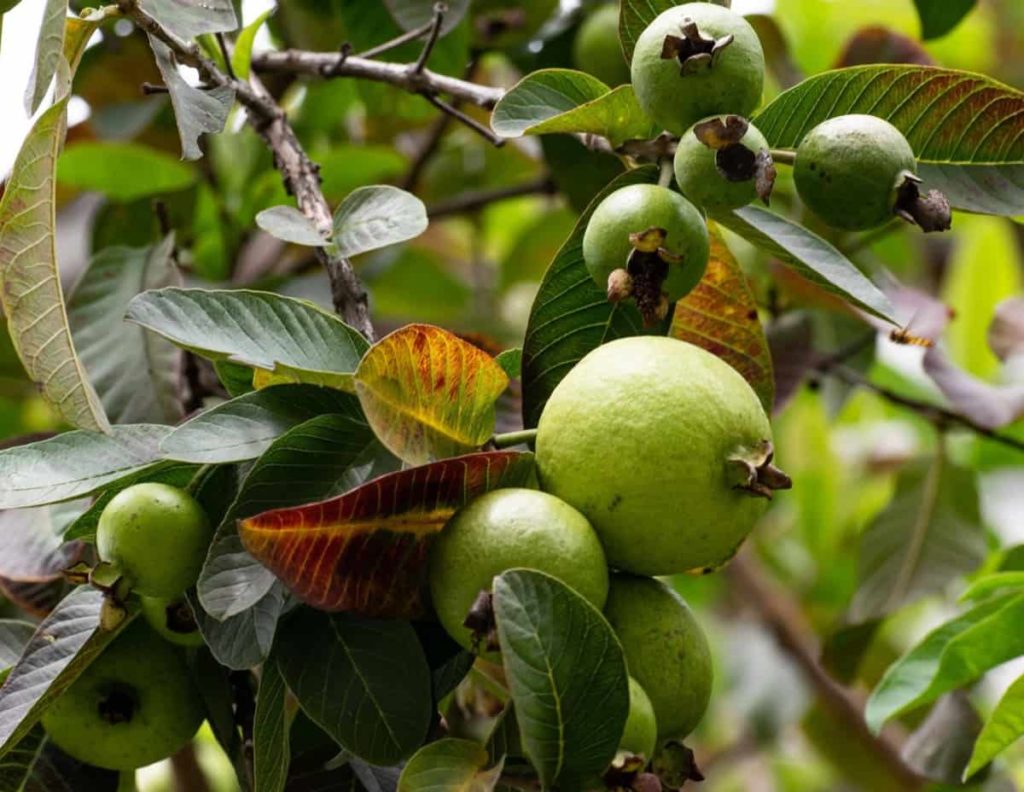
Organic manure for good fruit growth
Good quality fruits can be obtained by increasing the yield by adding 600 grams of neem cake per plant in Guava. 40 kg of cow dung or 4 kg of vermicompost 100 grams of organic fertilizer such as Azosprelium and Phosphorus soluble bacteria (PSB) can increase the yield of good quality fruits.
Apply fertilizer 2-3 feet away from the main stem. Fertilizers and fertilizers should be used based on soil tests. Continue irrigation at intervals of 10-15 days. Irrigate the Guava crop once a week during the flowering and fruiting stage.
Different ways of fertilizing Guava trees
Generally, the Guava tree is fed in two main ways: foliar spray and root or ground application. In the case of a foliar spray, the leaves of Guava trees are sprayed with a water-soluble fertilizer. This form of fertilizer provides nutrients for instant spraying of Guava plants. However, farmers commonly use foliar sprays to supplement their Guava orchards with additional nutrients such as copper, zinc, and manganese.
Guava trees must be completed once every two months if you use a foliar spray. Other best farming practices when using foliar sprays include: Avoid spraying your Guava trees more than once, usually every two months. Second, don’t spray your Guava with too much-concentrated fertilizer. When you are less than a year old, you need to dissolve in 16 ounces of water. And Guava grows well; you can dissolve it in 32 ounces of water.
Root or ground application involves fertilizing Guava trees with nutrients from the ground or root levels. There are some limitations to this method of feeding Guava. The nutrients must be absorbed from the roots into the stems, branches, and leaves. And it delays the distribution of nutrients to vital parts such as the reproductive system. However, using the root is also an excellent way to feed the plants as it improves the plants and the soil around them.
In case you missed it: Guava Grafting Methods; Pruning Methods; Training
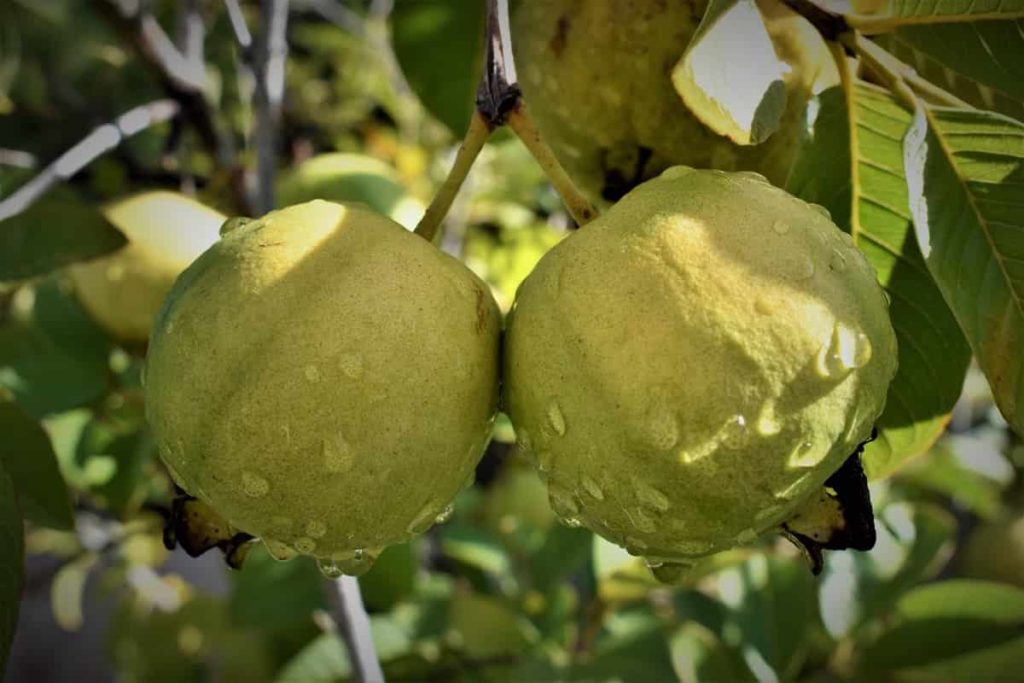
Commonly asked questions about Guava tree fertilizers
How can I increase the size of the Guava fruit?
Pre-flower sprays with 0.4% boric acid and 0.3% zinc sulfate increase yield and fruit size. Spraying 0.2 to 0.4% copper sulfate also increases the growth and yield of Guava. Guava plants begin to tolerate at an early age of about 2-3 years but attain full tolerance at 8-10 years.
What kind of fertilizer do trees need?
Like any other flowering plant, Guava trees need adequate amounts of nitrogen, potassium, phosphorus, and manganese.
How can we improve the quality of Guava?
Guava quality is obtained from various combinations of zinc sulfate and gibberellic acid to improve the physicochemical properties of Guava fruit.
Why are my Guava leaves turning red?
When the Guava leaves turn purple or red, the tree may be deficient in essential nutrients. It is especially true when they are grown in alkaline soils. Make sure the tree grows in the soil with some organic matter and add the right fertilizer to keep the tree healthy.
What are Guava trees, and what do they need to grow best?
Guava trees are evergreen fruit trees that grow in the tropics. For best growth, they need full sun exposure and well-drained soil. The essential nutrient for the Guava tree growth is nitrogen. Lack of nitrogen will cause the Guava leaves to turn yellow color, and the tree will not bear much fruit. Phosphorus is also important for flowers and fruits, while potassium helps fight disease and improve the tree’s overall health.
In case you missed it: Guava Farming Project Report, Cost and Profit Analysis
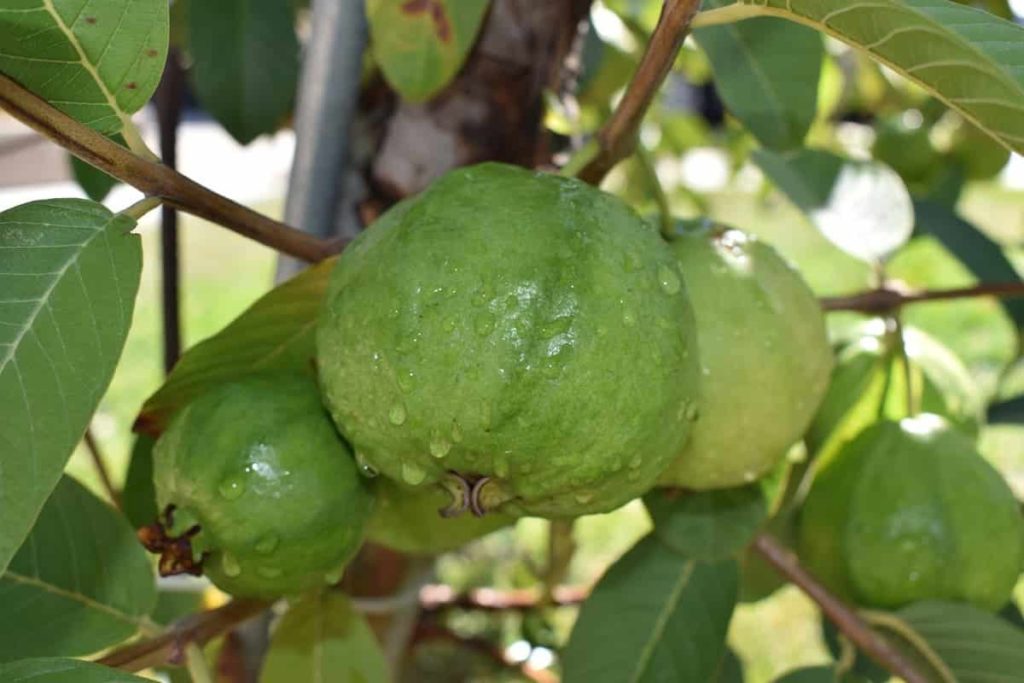
What are the benefits of using Guava tree fertilizer?
Guava trees are fertilized to improve their fruit growth, production, and quality. Fertilizers provide plants with essential nutrients such as nitrogen (N), phosphorus (P), and potassium (K). They also enhance the physical properties of soil by increasing its water retention capacity. With regular use, fertilizer can help Guava trees resist pests and diseases.
Conclusion
Knowing the basic fertilizer application for Guava trees can help you grow a large, strong, healthy plant. Successful Guava cultivation is grown in tropical and sub-tropical climate conditions. In areas with different winter seasons, yields increase, and quality improves. Although Guava is grown without any fertilizer and manure, it gives good yield and good quality fruit and responds well to its use. Therefore, the above fertilizer application is helpful for Guava tree growth.
- Economical Aquaculture: A Guide to Low-Budget Fish Farming
- 15 Common Planting Errors That Can Doom Your Fruit Trees
- How to Make Houseplants Bushy: Effective Tips and Ideas
- Innovative Strategies for Boosting Coconut Pollination and Yield
- Pollination Strategies for Maximum Pumpkin Yield
- The Complete Guide to Chicken Fattening: Strategies for Maximum Growth
- Natural Solutions for Tulip Problems: 100% Effective Remedies for Leaf and Bulb-Related Issues
- Revolutionizing Citrus Preservation: Towards a Healthier, Greener Future
- Natural Solutions for Peony Leaf and Flower Problems: 100% Effective Remedies
- Maximizing Profits with Avocado Contract Farming in India: A Comprehensive Guide
- Natural Solutions for Hydrangea Problems: 100% Effective Remedies for Leaf and Flowers
- The Ultimate Guide to Choosing the Perfect Foliage Friend: Bringing Life Indoors
- From Sunlight to Sustainability: 15 Ways to Use Solar Technology in Agriculture
- The Ultimate Guide to Dong Tao Chicken: Exploring from History to Raising
- The Eco-Friendly Makeover: How to Convert Your Unused Swimming Pool into a Fish Pond
- Mastering the Art of Delaware Chicken Farming: Essentials for Healthy Backyard Flocks
- 20 Best Homemade Fertilizers for Money Plant: DIY Recipes and Application Methods
- How to Craft a Comprehensive Free-Range Chicken Farming Business Plan
- Brighten Your Flock: Raising Easter Egger Chickens for Beauty and Bounty
- How to Optimize Your Poultry Egg Farm Business Plan with These Strategies
- Subsidy for Spirulina Cultivation: How Indian Government Schemes Encouraging Spirulina Farmers
- Ultimate Guide to Raising Dominique Chickens: Breeding, Feeding, Egg-Production, and Care
- Mastering the Art of Raising Jersey Giant Chickens: Care, Feeding, and More
- Ultimate Guide to Raising Legbar Chickens: Breeding, Farming Practices, Diet, Egg-Production
- How to Raise Welsummer Chickens: A Comprehensive Guide for Beginners
- How to Protect Indoor Plants in Winter: A Comprehensive Guide
- Ultimate Guide to Grow Bag Gardening: Tips, Tricks, and Planting Ideas for Urban Gardeners
- Guide to Lotus Cultivation: How to Propagate, Plant, Grow, Care, Cost, and Profit
- Agriculture Drone Subsidy Scheme: Government Kisan Subsidy, License, and How to Apply Online
- Ultimate Guide to Raising Araucana Chickens: Breed Profile, Farming Economics, Diet, and Care
- Bringing Hydroponics to Classroom: Importance, Benefits of Learning for School Students
- Ultimate Guide to Raising Polish Chickens: Breed Profile, Farming Economics, Diet, and Care
- Ultimate Guide to Raising Australorp Chickens: Profile, Farming Economics, Egg Production, Diet, and Care
- Silkie Chicken Farming: Raising Practices, Varieties, Egg Production, Diet, and Care
- Sussex Chicken Farming: Raising Practices, Varieties, Egg Production, Diet and Care
- Homemade Feed Formulations for Livestock: Discover Cost-effective Starter to Finisher Feed Recipes